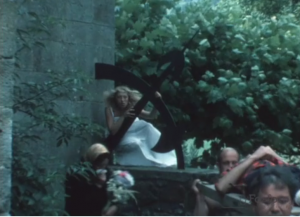
El filme comienza con un hombre vagando por el campo. Encuentra a una mujer vestida de blanco y comienzan a besarse, hasta que eventualmente caen sobre el pasto. El hombre lleva a la mujer vestida de blanco a conocer a una mujer mayor que la rechaza y la hace huir. El hombre va en su búsqueda y nota que ella tiene patas de pato, él cae al suelo y muera mientras ella coloca un pequeño costal café cerca de su pecho. La película muestra después a un grupo de hombres cargando su cuerpo hacia su ceremonia fúnebre mientras la mujer mayor llora detrás de la procesión y la mujer de blanco observa escondida en una esquina. Cuando el cuerpo es dejado solo, la mujer de blanco se aproxima para tomar el costal café y desaparece.
The film begins with a man wandering in the country. He finds a woman dressed in white and they begin to kiss, eventually falling on the grass. The man takes the woman dressed in white to meet an older woman who rejects her and makes her leave. He goes looking for the woman in white and sees that she has duck legs, he falls and dies while she places a small brown sack by his chest. The film then shows men carrying his body to his burial while the older woman cries behind the funeral procession and the woman in white watches hiding in a corner. When the body is left alone, the woman in white approaches him and takes the brown sack back and leaves.
"a ghost story, dealing partly with Victorian times and partly with the present day" (HMHT 1934: 490)
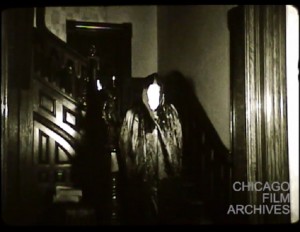
"A short mystery film from members of the Amateur Cinema League. A group of relatives gather in a haunted house for the reading of a will. Someone among them knows a secret about the house, and uses stories about the Black Widow to try and scare everyone away. In the end, their identity is revealed and all the secrets come to light. Title cards narrate the dialogue." Chicago Film Archives.
Visitors at a party receive a message from beyond that informs them, "There is a devil here!" and chaos follows. ‘Just before he died, the photographer of this film, Jack O' Hea, saw an article by Tony Rose, FACI, about the very first year of the Ten Best Competition and so this 'lost' film was rediscovered. It was made in 1934, just two years after Kodak had introduced the 8mm gauge. Music and 'devilish sound effects' were added by Jack O'Hea in 1978. These were revised and re-tracked for the IAC Library by the late Leslie Germany, FACI. The story, by John Burke, relates how the visitors at the Blackmores' party (one of whom is played by the director, Stanley Comber) receive a spirit-message that: 'There is a devil here!'. They link hands round the table and the hostess is attacked’ (EAFA Database).
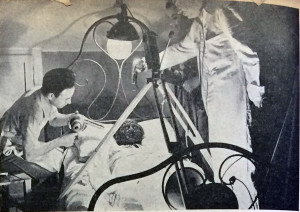
"a soggetto breve"/short fiction based on the eponymous novel by Edgar Allan Poe
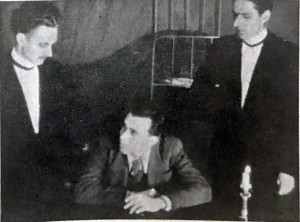
From the eponymous novella by Edgar Allan Poe
"II cuore rivelatore, realizzato da Alberto Mondadori, collaboratore Mario Monicelli, scenografia di Alberto Lattuada, operatore Cesare Civita; da un racconto di Edgar Allan Poe. lnterpreti Giuseppe Pedrini, Giuliano Carta. Abbiamo accennato tempo fa ad un film sperimentale americano sullo stesso soggetto, dovuto a R. P. Cobb. Interessante appare iI confronto con questo di Mondadori; in definitiva quello appare più surrealista, questo e invece più incisivo e reale preoccupandosi piuttosto Mondadori di creare l'atmosfera allucinata con uso non eccessivo di puri espedienti tecnici; ne consegue una maggior chiarezza nel racconto cinematografico, che procede abbastanza sostenuto anche per la buona interpretazione. Il regista non ha rinunciato tuttavia a quegli espedienti tecnici, come sovrimpressioni, ma ne ha usato in modo conveniente, senza esagerazioni . E' infine da tener presente l'intendimento di tentare nel campo della produzione italiana a passo ridotto, un genere diverso da i consueti."
"II cuore rivelatore (The Tell-Tale Heart), directed by Alberto Mondadori, with the collaboration of Mario Monicelli, set design by Alberto Lattuada, cameraman Cesare Civita, based on a story by Edgar Allan Poe. Some time ago, we mentioned to an American experimental film on the same subject by R. P. Cobb. Comparing it with this of Mondadori proves interesting; ultimately, that one appears more surrealist, while this one is instead more incisive and real since Mondadori concerns himself with creating the hallucinated atmosphere through a not excessive use of pure technical expedients; a greater clarity in the cinematographic story follows, which moves forward in a sustained enough fashion also for the good acting. The director has not abandoned himself to those technical expedients, such as superimpositions, but he has used them in a suitable way, without exaggerations. It is important, finally, to keep in mind the intention to try in the field of small-guage Italian production, a different genre from the usual."
—Il Ventuno 28 (Review of the G.U.F. of Venice), May 1935
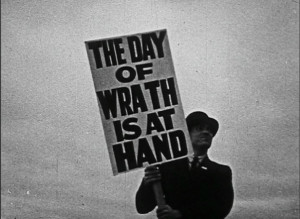
"Science fiction film influenced by the style of inter-war European art cinema." East Anglian Film Archive.
"Each year the contest sponsored by the American Society of Cinematographers through this magazine seems to bring forth a surprise. For several years the 8mm cinematrographers have been setting the pace, but never has any of them reached the goal achieved this year by Miss Ruth Stuart. Miss Stuart has been a contributor to this contest every year for the past three years; in 1933 she was given the medal for travel pictures. Her 200 ft. 16mm subject 'Doomsday' was also awarded honors in the British Institute of Amateur Cinematographers. In the American Society of Cinematographers contest just closed she was given a recognition for the Outstanding picture, in photography and Documentary pictures. It will be surprising to many that this unusual honor should befall a woman. Photography, by the unwritten law, is supposedly the realm of male species. Miss Stuart, however showed such a fine understanding of the value of pictures that move, how to fabricate these moving photographs into an interesting document that would hold any audience anywhere in the civilized world. For a person who films she must have developed a stony heart in order to cut as judiciously as the picture indicates. There is a tempo to the production that is very seldom achieved by an amateur. There are no obvious pet shots or scenes. Each sequence, each scene, each picture was left in production for a purpose to give it atmosphere to help the story along." American Cinematographer, Jan. 1937, 25.
"Well photographed, well planned film dealing with the contrasted fears of town and country folk and their reaction to catastrophe" (IAC 1975).
‘A fantasy based upon a fear which has preyed upon credulous minds from the beginning of time' is the maker's description of this ambitious attempt to show how people react to the possibility of a catastrophe and then to the real event. The story hinges upon a cosmic event that upsets the Earth's equilibrium, causes an imbalance of weather conditions and other natural forces, resulting in widespread panic’ (EAFA Database)."
"The film opens at the Atheneum Club where members are playing cards. They talk about a man named Pierpont who has an interest in the supernatural and has invited them to a séance the following day. At the séance Pierpont welcomes the visitors and introduces a man called Horace who will be the séance medium. Having set the scene by playing music and dimming the lights, Pierpont hypnotizes Horace and puts him into a wooden box. The séance continues with questions being asked to Horace in the box. When there is no answer, Pierpont opens the box and announces that Horace is dead. The horrified guests leave and find the police. On their return to the room, they find that the body is missing and Pierpont is questioned. Horace returns to the room alive and one of the guests remarks that this should be a lesson to them all" (MACE Online Archive).
"Drama based on H. G. Wells' story 'The Red Room' recounting how a guest mentions he has heard one of the house's rooms is haunted and that the last person to sleep in there was found dead with no explanation. The guest asks to spends a night in the haunted room seeing it as a challenge. He is provided with a large number of candles but will they be enough. When he is visited by a ghostly apparition determined to blow his candles out he tries to escape." (EAFA Database)
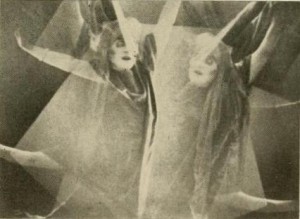
"The Fall of the House of Usher" not only represents a new cinema technique but it is also unique in that it does not attempt to tell Poe's story in detail, rather to invoke in its audiences the esthetic impressions and moods which the tale creates in its readers. This revolutionary approach to the cinema opens a fascinating field for further pioneering. Fortified with the new scientific instruments which have recently been devised for the detection and recording of emotional reactions, the amateur producer may now truly be said to face a new world for cinematic experimentation in translating such reactions into film. Properly motivated by medical authority films of this nature may even prove to have a tremendous psychological significance. From any viewpoint "The Fall of the House of Usher" represents a forecast of possibilities which are amazing." Movie Makers, January 1929, 847.
Total Pages: 3